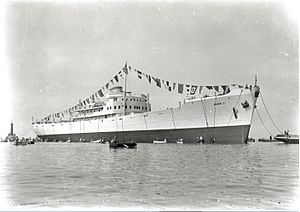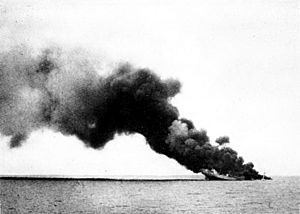Italian auxiliary cruiser Ramb I facts for kids
 |
|
Quick facts for kids History |
|
|---|---|
| Name | Ramb I |
| Builder | Ansaldo, Genoa |
| Yard number | 308 |
| Laid down | October 29, 1936 |
| Launched | July 22, 1937 |
| Commissioned | December 6, 1937 (as a merchant) |
| Reclassified | Auxiliary cruiser, June 9, 1940 |
| Homeport | Genoa |
| Identification | |
| Fate | Sunk by HMNZS Leander, 27 February 1941 |
| General characteristics | |
| Type |
|
| Tonnage |
|
| Length | 383 ft 2 in (116.79 m) |
| Beam | 49 ft 7 in (15.11 m) |
| Depth | 24 ft 8 in (7.52 m) |
| Installed power | 1525 Nhp |
| Propulsion |
|
| Speed | |
| Capacity |
|
| Complement | 120 |
| Armament |
|
| Service record | |
| Part of: | Red Sea Flotilla |
| Commanders: | Alfredo Bonezzi |
The Ramb I was an Italian ship built before World War II. It was first designed as a "banana boat" to carry fruit. Later, it was changed into an auxiliary cruiser, which is like a merchant ship armed for war.
The Ramb I served as an armed merchant ship in the Red Sea. When the city of Massawa fell to the Allies, the ship was told to sail all the way to Japan. However, it was sunk in the Indian Ocean before it could reach its destination.
Building the Ramb I
In the late 1930s, the Italian government wanted four new ships. These ships were meant to carry bananas from Mogadishu in Italian Somaliland to Naples, Italy. They needed to be large enough to hold a lot of cargo and travel long distances without stopping.
These four special ships were managed by a company called Regia Azienda Monopolio delle Banane (RAMB). Two of the ships were built in Monfalcone, and two, including Ramb I, were built in Genoa. The Ramb I was built between October 1936 and December 1937.
These ships were quite modern for their time. They could carry about 2,400 tons of cargo. They also had space for 12 passengers. Passengers had a fancy apartment or twin bedrooms. They even had their own private deck, a dining room with views, and air conditioning!
The Ramb I was a fast ship. It could go up to 18.5 knots (about 34 km/h). Its normal cruising speed was 17 knots (about 31 km/h). The ship weighed 3,667 tons. It was powered by two large FIAT diesel engines.
The ships were designed so they could be easily turned into warships if needed. They had special spaces on deck for four large 120mm cannons. The cannons and other military gear were kept ready in Massawa and Naples.
Before the war, the Ramb I did its job well. It carried bananas from Italian Somaliland to Venice, Naples, and Genoa. On its way back, it would carry other goods to Mogadishu.
Ramb I at War
On June 9, 1940, the Ramb I was taken over by the Regia Marina (the Italian Navy) in Massawa. It became part of the Red Sea Flotilla. When Italy joined World War II, only one of the four RAMB ships was in the Mediterranean Sea. The other three, including Ramb I, were in the Red Sea. They couldn't get back to Italy.
The Ramb I was then fitted with weapons in Massawa. It received four 120mm cannons and two (or four) 13.2mm anti-aircraft guns. These guns helped protect the ship from enemy planes.
During the war in Eastern Africa, the Ramb I wasn't very busy. It only went on one mission in August 1940 to attack an enemy merchant ship, but it wasn't successful. Mostly, the ship was used to help defend Massawa from air attacks.
As the war continued, it became clear that Italian forces in Italian East Africa were cut off. Fuel supplies were running low. So, a plan was made to send as many ships as possible to Japan or France. Any ships that couldn't make the long journey were to be destroyed. The Ramb I, along with the ship Eritrea and Ramb II, were chosen to try and reach the Far East.
The Ramb I, Ramb II, and Eritrea left Massawa around February 20, 1941. The two auxiliary cruisers, Ramb I and Ramb II, were heading for Nagasaki. The Eritrea was going to Kobe.
After leaving Massawa, all three ships carefully sailed past Perim. They avoided British Navy ships and planes from Aden and Socotra. They then passed through the Bab-el-Mandeb Strait and the Gulf of Aden to enter the Indian Ocean.
The Sinking of Ramb I
The Royal New Zealand Navy light cruiser HMNZS Leander was sailing in the northern Arabian Sea. It was looking for a German cruiser and other disguised enemy ships. On February 25, 1941, the city of Mogadishu fell to the Allies. The captain of HMNZS Leander, Robert Hesketh Bevan, thought that some Italian ships might try to escape through his area.
Early on February 27, 1941, HMNZS Leander spotted the Ramb I in the northern Arabian Sea. The cruiser got closer, about 6 miles away. It signaled the Ramb I to stop its engines and show its papers. At this time, the Italian ship was flying the British flag to hide its true identity.
The Ramb I gave false information. HMNZS Leander then asked for a secret war code. Captain Bonezzi of the Ramb I knew he couldn't answer. He decided there was no choice but to fight. The British flag was lowered, and the Italian flag was raised. The Ramb I opened fire on the enemy cruiser from about 3,000 yards away.
The fight lasted about twenty minutes. HMNZS Leander was hit once. But it quickly fired back five times, hitting the Ramb I badly and setting it on fire. The Ramb I lowered its flag, and HMNZS Leander stopped shooting. Captain Bonezzi ordered his crew to leave the ship and sink it.
HMNZS Leander rescued Captain Bonezzi and 112 other men. Sadly, one of them later died from burns. The charges to sink the Ramb I went off soon after, and the ship sank. The survivors were taken to Addu Atoll. Later, a tanker ship took them to prisoner of war camps in Colombo, Ceylon.


